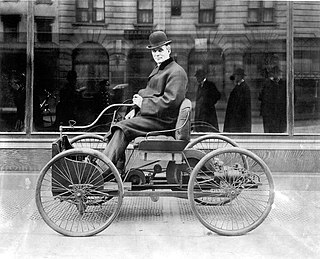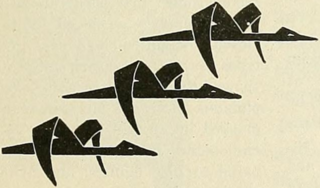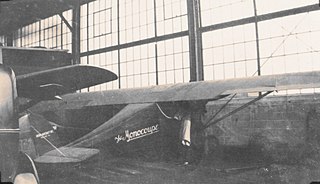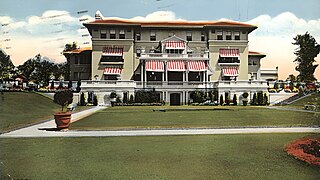
The Franklin Automobile Company was a marketer of automobiles in the United States between 1902 and 1934 in Syracuse, New York. Herbert H. Franklin, the founder, began his career in the metal die casting business before establishing his automobile enterprise. Controlled by Herbert H. Franklin it had very few other significant shareholders. Franklin bought its vehicles from the H. H. Franklin Manufacturing Company which was only moderately profitable and frequently missed dividends on common stock.

Marmon Motor Car Company was an American automobile manufacturer founded by Howard Carpenter Marmon and owned by Nordyke Marmon & Company of Indianapolis, Indiana, US. It produced luxury automobiles from 1902 to 1933.

The Ford Model N is an automobile produced by Ford Motor Company; it was introduced in 1906 as a successor to the Models A and C as the company's inexpensive, entry-level line. It was built at the Ford Piquette Avenue Plant.

Elmore Manufacturing Company was a manufacturer of veteran and brass era automobiles and bicycles (1893–97), headquartered at 504 Amanda Street, Clyde, Ohio, from 1893 until 1912. The company took its name from a small parcel of land in Clyde with the name Elmore associated with it where a stave mill was established originally, then evolved into bicycle production. The village of Elmore, Ohio is located 20 mi (32.2 km) to the east. Founded by Harmon Von Vechten Becker and his two sons, James and Burton, the Elmore used a two-stroke engine design, in straight twin or single-cylinder versions. They later produced a straight-3 followed by a straight-4 beginning in 1906 until production ended in 1912. The company advertising slogan was "The Car That Has No Valves", referring to the two-stroke engine.

Grout Brothers was a manufacturer of steam-powered automobiles in Orange, Massachusetts. The three brothers, Carl, Fred and C.B. were set up in business by their father William L., who had made sewing machines under the New Home name in partnership with Thomas H. White. The early cars were sold under the New Home name.
The National Motor Vehicle Company was an American manufacturer of automobiles in Indianapolis, Indiana, between 1900 and 1924. One of its presidents, Arthur C. Newby, was also one of the investors who created the Indianapolis Motor Speedway.

Templar was a manufacturer of automobiles in Lakewood, Ohio from 1917 to 1924. The company was named for the Knights Templar and used a Maltese Cross as an emblem.

The Ford Quadricycle was the first vehicle developed by Henry Ford. Ford's first car was a simple frame with a gas-powered engine and four bicycle wheels mounted on it.

Scripps-Booth was a United States automobile marque based in Detroit, Michigan. Established by James Scripps Booth in 1913, Scripps-Booth Company produced motor vehicles and was later acquired by General Motors, becoming a division of it, until the brand was discontinued in 1923.
The Austin was a brass era American automobile manufactured in Grand Rapids, Michigan from 1901 to 1921. The company, founded by James E. Austin and his son Walter Austin, built large, expensive and powerful touring cars with an unusual double cantilever rear spring arrangement placing the rear wheels behind the passenger compartment, for a longer wheelbase to improve rider comfort in an era of rough roads as well as a unique two-speed rear axle.

Monocoupe Aircraft was a manufacturer of light airplanes originally produced in the late 1920s and 30s. They introduced relatively inexpensive, compact, and sporty aircraft in an era of large, maintenance intensive, open-cockpit biplanes, and the Monocoupe series was one of the first economical, closed-cabin, two-seat, light aircraft in the United States. As a result, the Monocoupe soon became a successful brand.

The Velie Monocoupe was an American general aviation aircraft manufactured from 1927 to 1929 by the Mono-Aircraft Corp, a division of Velie Motors Corporation.

Western Tool Works was an American brass era automobile manufacturer in Galesburg, Illinois. The company made Gale automobiles from 1904 to 1910. Early Gale runabouts were notable for having bodywork hinged at the rear of the car that could be lifted to ease access to the engine, essentially making the entire body the hood.
The Success Automobile Manufacturing Company was a brass era United States automobile manufacturer, located at 532 De Ballviere Avenue, St. Louis, Missouri, in 1906.
The Colt Runabout was an American Brass-era automobile built in Yonkers, New York, in 1907. by William Mason Turner.

Midland Motor Company was an American brass era automobile manufacturer in Moline, Illinois from 1908 to 1913.

Daniels Motor Company was a pioneer brass era American automobile company, founded in 1915 by George E. Daniels with Neff E. Parish. George Daniels was a known lawyer, engineer, and mechanic. He was considered the best motorcar designer in the United States. Neff Parish had his own automobile parts and framing manufacturing company. Neff was the creator of the time's highest-grade heat-treated alloy steel frames, respected in the steel industry. Daniels Motor Company produced 1,500 high-quality automobiles between 1916 and 1924, branding themselves as “the distinguished car with just a little more power than you will ever need”, and “The aristocrat of American cars”.
The American Automobile and Power Company was an American Brass Era car manufacturer, incorporated in Sanford, Maine, in 1903. They produced the American Populaire during 1904 and 1905.

Willard Lamb Velie was a businessman based in Moline, Illinois. He was an executive at Deere & Company before starting his own companies, which grew to become Velie Motor Company. He developed advanced engines for automobiles and airplanes.

The Central States Aircraft Model 22, Velie Monocoupe, or Monocoupe Model 22 was the first in a series of small, high-performance high-wing monoplanes from Monocoupe Aircraft.


















